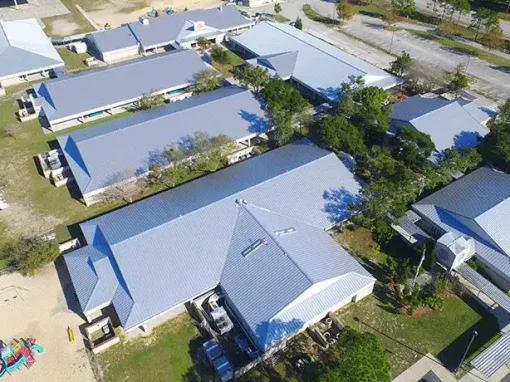Built-Up Roofing
Home //
Built-Up Roofing Systems
Built-Up Roofing Systems: A Reliable Solution for Florida Businesses

Benefits
Benefits of Commercial Built-Up Roofing Systems in Florida
Exceptional Weather Resistance:
BUR systems perform exceptionally well in Florida’s punishing weather conditions, including intense sun, heavy rainfall, strong winds, and hail.
Waterproofing and Leak Protection: The layered construction creates a robust barrier against water intrusion, ensuring your roof remains watertight.
Self-Healing Properties:
The bitumen layers are self-sealing, which helps reduce the likelihood of leaks and cracks over time.
Thermal Efficiency:
Built-up roofing systems provide excellent insulation, reflecting heat and reducing energy costs—a critical feature in Florida’s hot climate. Longevity: With proper installation and maintenance, BUR can last for decades, offering exceptional value for commercial property owners.

Hot Mop Asphalt Coating: Durable Roofing Solutions for Commercial Properties
What is Hot Mop Asphalt Roofing?

A History Rooted in Performance
Benefits of Hot Mop Asphalt Roofing
Benefits of Hot Mop Asphalt Roofing for Florida Commercial Buildings
Durability
These roofs are designed to last, providing decades of reliable performance with minimal maintenance.
Weather Resistance
Hot mop asphalt is particularly well-suited for Florida’s challenging weather, including heavy rain, high winds, and intense sun.
Adaptability
This system conforms to various roof shapes, making it ideal for large flat roofs on commercial properties like schools, healthcare facilities, and condominiums.
Cost-Effective Longevity
Why Choose Commercial Hot Mop Asphalt Coating Contractor
Choosing a Commercial Hot Mop Asphalt Coating Contractor in Florida
Whether you need a new installation, maintenance, or repairs, our team is ready to deliver top-tier service. Trust us to protect your property with a durable, weather-resistant roofing solution tailored to Florida’s demanding environment.
Process
The Hot Mop Process
The installation process is a roofing method that requires the application of layers of hot asphalt and felt to build a robust and durable surface. Below, we will detail each of the steps involved in a successful installation:
Preparation:
Before starting the hot mopping process, one must verify that the roof surface is immaculate and debris-free. In addition, repair any damage or cracks in the roof surface before proceeding with the installation.
Asphalt Application:
The hot asphalt is applied to the roof surface in layers using a mop or roller. Each layer should be applied evenly and appropriately to ensure a solid and durable surface.
Laying the Felt:
The felt is placed on the hot asphalt and firmly pressed into the selected space to ensure proper adhesion.
Repeat The Process:
The application of layers of asphalt and felt should be repeated until the desired number of layers has been created. Each layer should be uniform and of adequate thickness to ensure a solid and durable surface.
Finishing:
After all required coats have been applied, a final hot asphalt coat should seal the surface. Additional finishes, such as hop mop roofing with gravel or tiles, can be used depending on the desired result.
Regarding the materials and tools used for the hot-mop roofing process, hot asphalt, felt, a mop or roller, a torch, cutting tools, and adhesives are required. In addition, safety measures, such as protective clothing, personal protective equipment (PPE), and adequate ventilation, must be implemented.
In addition, there are safety considerations and practices that should be considered for hot mop asphalt roofing, including fire-resistant protective clothing, proper PPE, adequate ventilation, and formal training for personnel involved in the roofing process. It is also necessary to have appropriate planning and constant monitoring of the process to ensure the safety of the workers and the quality of the work performed.
Number of Layers
How many Layers does a Hot Mop Roof have?
A hot mop roof comprises several layers, usually varying between 2 and 4 depending on building type, climate, and roof conditions. Below, we share an overview of the layer system applied in this roofing process.
this is the first layer of asphalt applied on the roof. The function of this layer is to provide a solid base for the rest of the coating system and to help seal the roof against water ingress.
consists of one or two layers of asphalt and felt and is applied over the base layer. The function of this layer is to help increase the strength and durability of the roof and provide a more uniform surface for the top layer.
consists of one or two layers of asphalt and felt and is applied over the middle layer. The function of this layer is to protect the roof surface from water, sun, and other elements.
this is the last layer of the system and is composed of a layer of asphalt or protective coating. The function of this layer is to help seal the roof and provide a more resistant and durable surface.
Regarding the future of asphalt roofing systems, it is expected that innovations in material technology and sustainability will drive the development of suitable roofing systems with high strength and durability. In addition, such systems will likely be increasingly integrated with solar energy, allowing renewable energy to be generated and reducing costs for building owners.
Further Improvement
Maintenance and repair of hot mop roofs
Proper maintenance and repair are essential to ensure the durability and performance of a hot mop roof, so it is crucial to follow specific tips to keep it in good condition. Here are some of them:
- Regular inspection: roof inspections are indispensable to detect any damage or wear and tear in time, especially after extreme weather events.
- Cleaning: keep the roof completely clean and debris-free to prevent water buildup, mold, and mildew.
- Leak repair: fix any leaks or damage as soon as you detect them to avoid worsening the problem and causing further damage.
- Professional maintenance: hire a professional to perform regular hot mop roof maintenance and repairs.
However, during these types of maintenance and repair processes, some hot mop roofing problems can occur, such as cracking and blistering of the roof surface, wear and aging of the roof surface, water and moisture damage, damage from UV exposure, and even problems with sealing joints and connections.
Usually, these types of problems are caused because, during these processes, the professionals do not follow the manufacturer’s instructions, do not use the proper personal protective equipment, do not follow safety protocols, or do not perform regular inspections.
To avoid these circumstances, an excellent option is to apply hot mop roof repair strategies that include patching damaged areas, replacing damaged areas of the roof, and using additional layers of asphalt and felt to increase the roof’s strength and durability exponentially.
In addition, to ensure a longer life of the hot mop systems, it is necessary to perform regular inspections during maintenance, keep the roof clean and free of debris, and perform professional repairs and maintenance when required. Following the manufacturer’s instructions and avoiding common mistakes during installation and maintenance is essential to ensure excellent results.
Conclusion
Hot mop asphalt roofing Florida is popular for commercial and residential roofing construction due to their strength and durability. The hot mop installation process requires the application of layers of asphalt and felt to create a solid surface. But, performing proper maintenance and repair with a trusted company like Advanced Roofing.
Regarding the advantages and disadvantages of hot mop roofing versus TPO and BUR, hot mop roofing systems are more recommended due to their strength and durability. However, they can be more expensive than other roofing systems. On the other hand, TPO and BUR roofing systems are popular choices because of their strength, durability, and lower cost.
Pro tip: If you are interested in learning more about hot mop roofing, there are many resources available online, such as installation and maintenance guides, instructional videos, and online discussion forums that you can access. You can also look for online or in-person training courses to learn more about installing and maintaining warm mop ceilings.
Benefits
Benefits of Built-Up
- Qualify for coatings
- Self-healing
- Proven track-record
- Superior waterproofing capabilities
- Rated for high-wind speeds
- Up to 30-year warranty available
Testimonials
Read Our Google Reviews
Advanced Roofing Company distinguishes itself with its professionalism, equipped with the manpower and cutting-edge equipment necessary to effectively service a large FBO and Real Estate company like ours. Their team exhibits a profound understanding of the unique challenges posed by commercial roofing, consistently delivering results that meet our high standards.
What truly sets Advanced Roofing Company apart is their commitment to customer satisfaction. While no company is without its occasional issues, Advanced Roofing demonstrates a commendable dedication to resolving any issues promptly and effectively. Whenever challenges arise, they respond swiftly, making the necessary corrections and standing firmly behind their work.
This level of accountability instills confidence in their services and reinforces our trust in their capabilities. Advanced Roofing Company’s willingness to take ownership of any issues underscores their integrity and ensures that our roofing needs are consistently met with excellence.
In conclusion, Advanced Roofing Company has proven to be a dependable roofing partner for our commercial properties at Fort Lauderdale Airport. Their professionalism, responsiveness, and unwavering commitment to quality make them a standout choice for any organization seeking reliable roofing solutions. We highly recommend Advanced Roofing Company to anyone in need of roofing services backed by integrity and expertise.
Larry Warner
Facilities Manager
Sheltair Aviation
Advanced Roofing Company distinguishes itself with its professionalism, equipped with the manpower and cutting-edge equipment necessary to effectively service a large FBO and Real Estate company like ours. Their team exhibits a profound understanding of the unique challenges posed by commercial roofing, consistently delivering results that meet our high standards.
What truly sets Advanced Roofing Company apart is their commitment to customer satisfaction. While no company is without its occasional issues, Advanced Roofing demonstrates a commendable dedication to resolving any issues promptly and effectively. Whenever challenges arise, they respond swiftly, making the necessary corrections and standing firmly behind their work.
This level of accountability instills confidence in their services and reinforces our trust in their capabilities. Advanced Roofing Company’s willingness to take ownership of any issues underscores their integrity and ensures that our roofing needs are consistently met with excellence.
In conclusion, Advanced Roofing Company has proven to be a dependable roofing partner for our commercial properties at Fort Lauderdale Airport. Their professionalism, responsiveness, and unwavering commitment to quality make them a standout choice for any organization seeking reliable roofing solutions. We highly recommend Advanced Roofing Company to anyone in need of roofing services backed by integrity and expertise.
Larry Warner
Facilities Manager
Sheltair Aviation
Roof Replacement Resources

DARE TO COMPARE
How do other roofing contractors stack up to Advanced Roofing?
We Dare You To Compare!

HOW TO SELECT A ROOFER
View our guide on how to select a commercial roofing contractor in Florida.

COMMON ROOF ISSUES
Learn about 5 common roof problems you can prevent with annual maintenance and repairs.

GAF ROOFING MANUAL
Want the secret to a leak free roof for 25 Years? Download the GAF Roofing Solutions reference manual.
Featured Projects























